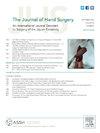Nonsurgical Treatment Versus Surgical Treatment in Displaced Metacarpal Spiral Fractures: Extended 4.5-Year Follow-Up of a Previously Randomized Controlled Trial
IF 2.1
2区 医学
Q2 ORTHOPEDICS
引用次数: 0
Abstract
Purpose
Spiral or oblique fractures of the metacarpals of rays II−V are common and often managed nonsurgically. Surgery is typically recommended for fractures with displacement or rotational deformity. In a recent randomized controlled trial of displaced fractures, nonsurgical treatment with early unrestricted mobilization was found to be noninferior to surgical treatment at the 1-year follow-up. However, long-term outcomes comparing these approaches have not been reported. This study evaluated whether treatment differences emerge at the midterm follow-up, hypothesizing that nonsurgical treatment will remain noninferior.
Methods
Of 42 patients with displaced spiral/oblique metacarpal shaft fractures enrolled in our previous randomized controlled trial, 34 were analyzed at a mean of 4.5 years postinjury (range: 3.1–6.6 years). The primary outcome was grip strength of the injured hand relative to the uninjured hand, with and without adjustment for hand dominance. Secondary outcomes included the Disabilities of the Arm, Shoulder, and Hand score, range of motion, rotational deformity, complications, and patient-rated pain.
Results
Nonsurgical treatment remained noninferior within the predefined margin. The mean grip strength was 95% of the uninjured hand in the nonsurgical group and 95% in the surgical group. After adjusting for hand dominance, the mean grip strength was 103% of the uninjured hand in the nonsurgical group and 96% in the surgical group. Secondary outcomes were similar between the groups.
Conclusions
Nonsurgical treatment with early unrestricted mobilization remains noninferior to surgical treatment at the midterm follow-up. These findings support the viability of this treatment option for displaced single spiral or oblique metacarpal shaft fractures of rays II–V in patients who prefer nonsurgical treatment.
Type of study/level of evidence
Therapeutic II.
非手术治疗与手术治疗移位型掌骨螺旋骨折:一项先前随机对照试验延长4.5年随访。
目的:II-V线掌骨螺旋或斜向骨折是常见的,通常采用非手术治疗。对于移位或旋转畸形的骨折,通常推荐手术治疗。在最近一项针对移位性骨折的随机对照试验中,在1年随访中发现,非手术治疗早期无限制活动的效果不逊于手术治疗。然而,比较这些方法的长期结果尚未报道。本研究评估了在中期随访中是否出现治疗差异,假设非手术治疗将保持良好。方法:我们之前的随机对照试验纳入了42例移位的螺旋/斜掌骨干骨折患者,其中34例在损伤后平均4.5年(范围:3.1-6.6年)进行了分析。主要结果是受伤手相对于未受伤手的握力,有或没有调整手优势。次要结果包括手臂、肩膀和手的残疾评分、活动范围、旋转畸形、并发症和患者评价的疼痛。结果:非手术治疗在预定范围内保持良好。平均握力是非手术组未受伤手的95%,手术组为95%。调整手部优势后,非手术组的平均握力为未受伤手的103%,手术组为96%。两组间的次要结果相似。结论:在中期随访中,早期无限制活动的非手术治疗仍然不逊于手术治疗。这些研究结果支持这种治疗方案对于II-V线移位的单螺旋或斜向掌骨干骨折的可行性,这些患者更倾向于非手术治疗。研究类型/证据水平:治疗性II。
本文章由计算机程序翻译,如有差异,请以英文原文为准。
求助全文
约1分钟内获得全文
求助全文
来源期刊
CiteScore
3.20
自引率
10.50%
发文量
402
审稿时长
12 weeks
期刊介绍:
The Journal of Hand Surgery publishes original, peer-reviewed articles related to the pathophysiology, diagnosis, and treatment of diseases and conditions of the upper extremity; these include both clinical and basic science studies, along with case reports. Special features include Review Articles (including Current Concepts and The Hand Surgery Landscape), Reviews of Books and Media, and Letters to the Editor.

 求助内容:
求助内容: 应助结果提醒方式:
应助结果提醒方式:


